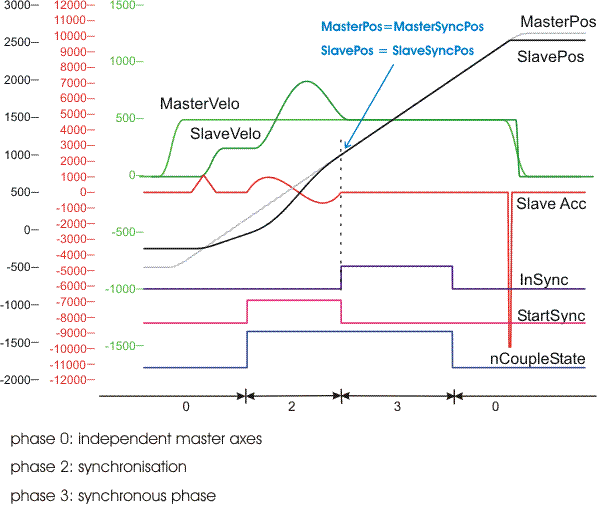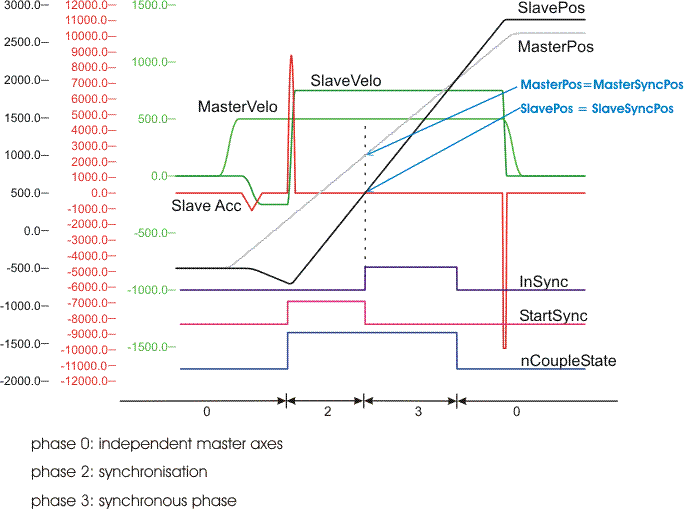Synchronisation to position
In the case of synchronisation to position, the slave axis, starting from its initial state, is synchronised to the master axis in such a way that the required synchronous velocity (vmaster·= coupling factor) and synchronisation position are achieved precisely at the master's synchronisation position.
The synchronisation phase of the slave axis is calculated in such a way that the boundary conditions specified by the user are maintained. Calculation and checking of these boundary conditions is carried out under the assumption that the master axis will continue to move without acceleration after the coupling time. If the master axis is not free moving, some overshoot or undershoot of the parameterised boundary conditions may occur.
Example 1:
In the example illustrated, the future master and slave axes are independently started, moving in positive directions. At the time of the illustrated phase change from 0 to 2, the Universal Flying Saw is started with synchronisation to position (StartSync = 1). Synchronisation to position means that the slave axis reaches the synchronous velocity precisely as the master is at the master synchronisation position (master-sync-position) and when the slave is at the slave synchronisation position (slave-sync-position). The synchronous velocity corresponds to the master velocity multiplied by the chosen coupling factor. In the example illustrated here, the master-sync-position is identical to the slave-sync-position, which means that the master and slave positions are the same when the InSync signal provides a rising edge. In this example, 1 has been selected as the coupling factor, so that the master and slave velocities in the synchronous phase (3) are identical. At the time when the phase changes from 3 to 0, the slave axis is uncoupled from the master axis (online change), and then continues to move once again as an independent master axis. The slave axis changes to a master axis online at the uncoupling time. This online change will remove any acceleration or deceleration to which the slave may be subject, thus fixing the velocity of the former slave, with which it will then continue to move without limit.
The phase currently applying to the slave axis can be seen in the nAxisState variable in the cyclic axis interface. (The names of the individual phases in the illustrations do not agree with the values of the nAxisState variable.)
(* Start parameters *)
fMasterVelo := 500;
fSlaveVelo := 250;
fMasterStartPos := -500;
fSlaveStartPos := -250;
(* Coupling parameters *)
fGearRatio := 1;
fMasterSynchronPos := 1000;
fSlaveSynchronPos := 1000;
fSlaveAcc := 2500;
fSlaveDec := 2500;
fSlaveJerk := 5000;

Example 2:
(* Start parameters *)
fMasterVelo := 500;
fSlaveVelo := -250;
fMasterStartPos := -500;
fSlaveStartPos := -500;
(* Coupling parameters *)
fGearRatio := 1.5;
fMasterSynchronPos := 1000;
fSlaveSynchronPos := 500;
fSlaveAcc := 10000;
fSlaveDec := 10000;
fSlaveJerk := 50000;
PLC function blocks
The function block MC_GearInPos is used for coupling. To end the synchronous phase, i.e. for uncoupling (online change of the slave into an independent master), the function block MC_GearOut is used.